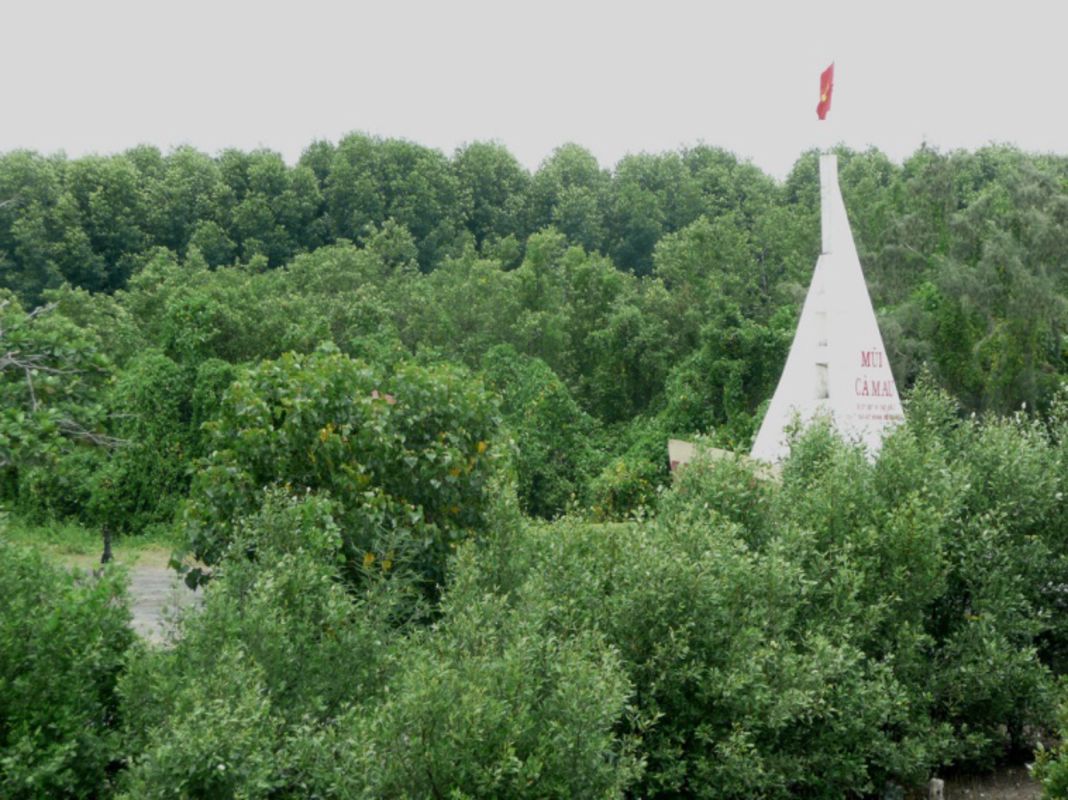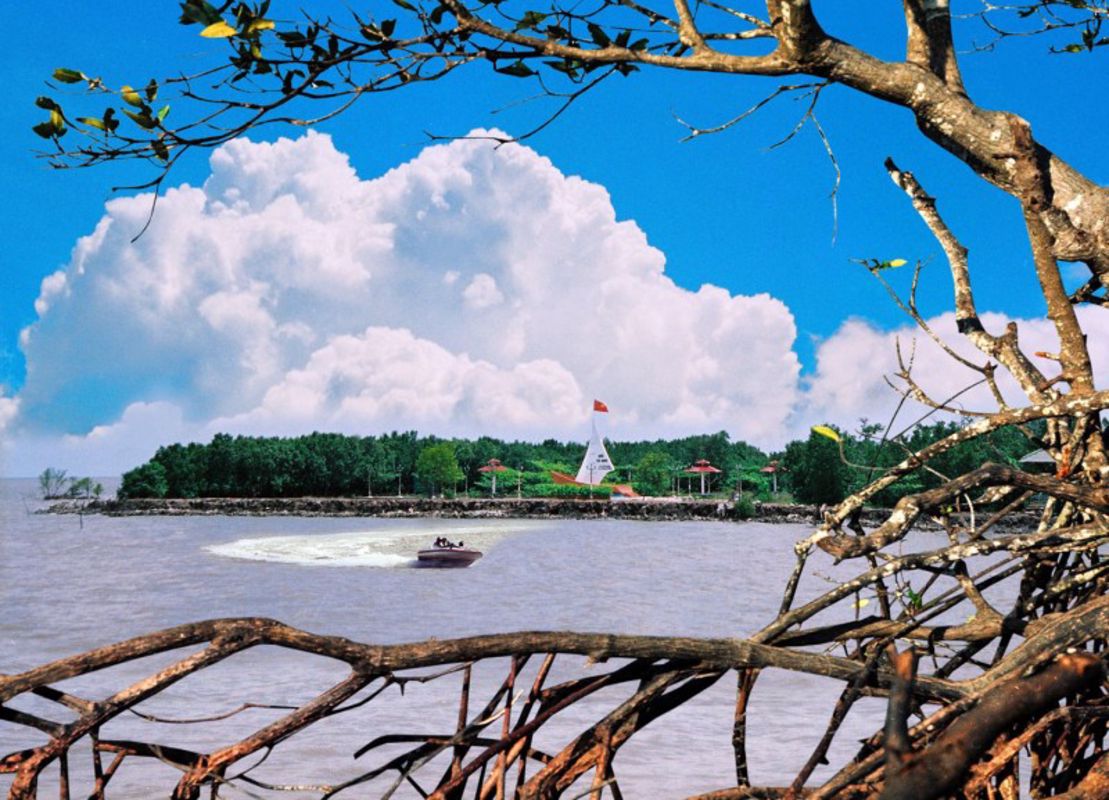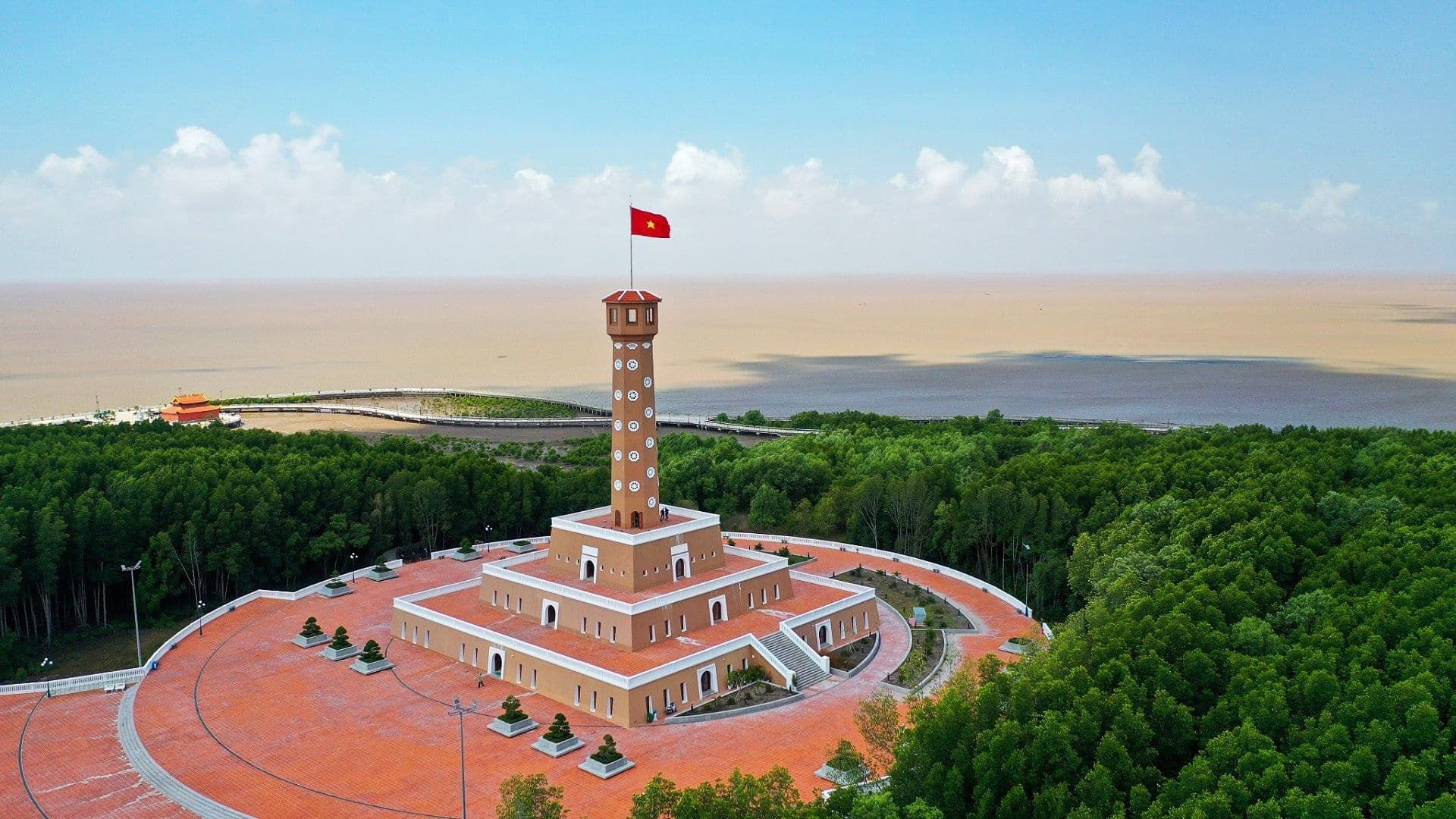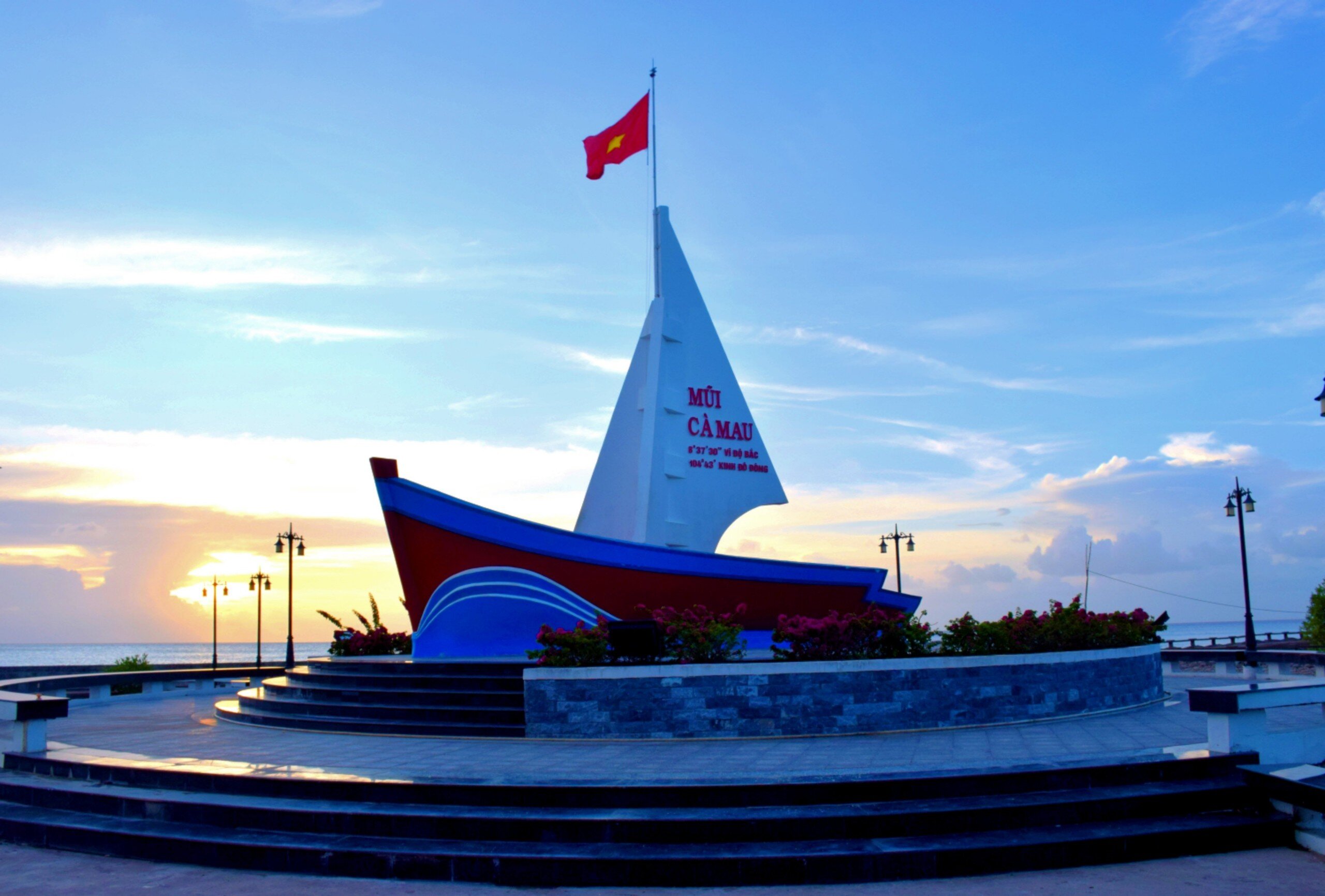Discover Ca Mau Cape, Vietnam’s southernmost point, with its mangroves, unique tides, and cultural significance. Book eco-friendly tours with Legend Travel Group for an unforgettable Mekong Delta adventure.
Ca Mau Cape, the southernmost tip of Vietnam, is more than a geographical marvel; it’s a symbol of national pride and a testament to nature’s resilience. Located in Dat Mui Ward, Ngoc Hien Commune, Ca Mau Province, this iconic point within Mui Ca Mau National Park draws 50,000 visitors annually, captivated by its mangrove forests, unique tidal ecosystems, and the rare opportunity to witness both sunrise over the East Sea and sunset over the Gulf of Thailand from the same spot. Following Vietnam’s administrative reform, Ca Mau Province now includes the former Bac Lieu ward, enhancing its cultural and ecological diversity with a population of 1.8 million, including Kinh, Khmer (20%), and Hoa communities. The tropical monsoon climate (dry season: November–April, 24–32°C or 75.2–89.6°F; rainy season: May–October, 26–36°C or 78.8–96.8°F) and fertile alluvial soil create a thriving habitat, making Ca Mau Cape a haven for eco-tourism and cultural exploration.
Far from the outdated portrayal of a remote, untouched land, Ca Mau Cape is now accessible yet retains its wild charm, with modern infrastructure like the Ho Chi Minh Trail and eco-friendly transport options. Legend Travel Group, a sustainable tourism leader since 2008, offers immersive tours to Ca Mau Cape, using electric boats, bicycles, and local guides to connect travelers with its natural and cultural treasures while minimizing environmental impact. Contact us at WhatsApp: +84825862222 or email: sales@legendtravelgroup.com to book your adventure.
Use “Ca Mau Cape, Ca Mau Province” for navigation. As Vietnam’s southernmost landmark, it’s a must-visit for those seeking a blend of natural wonder and national significance.
With 17 years of expertise, Legend Travel Group serves 20,000 travelers yearly across Vietnam, Cambodia, Laos, Thailand, and Myanmar, prioritizing sustainable tourism. Our Ca Mau Cape tours feature eco-friendly transport, English-speaking guides with deep local knowledge, and partnerships with community-based providers to preserve Mekong Delta traditions. Enjoy transparent pricing, free cancellations up to 48 hours prior, and 24/7 support. Book through this guide for a responsible, immersive journey aligned with Vietnam’s green tourism vision.
 Photograph the natural allure of Ca Mau’s heritage (Source: Internet)
Photograph the natural allure of Ca Mau’s heritage (Source: Internet)Ca Mau Cape, once described solely as a mangrove-clad outpost, is a vibrant destination within the 41,862-hectare Mui Ca Mau National Park, a UNESCO-recognized World Biosphere Reserve and Vietnam’s fifth Ramsar site. Located at coordinates 8°37'30"N, 104°43'E, the cape’s iconic GPS 0001 marker, shaped like a ship with billowing sails, symbolizes Vietnam’s maritime heritage and sovereignty. Unlike older narratives focusing on its slow expansion (50–80 meters annually into the Gulf of Thailand), modern Ca Mau Cape is a hub of eco-tourism, with the Ho Chi Minh Trail now extending to Dat Mui, making it accessible by road from Ca Mau City (100 km, 2.5–3 hours by car). Waterways, however, remain a popular and immersive way to explore, offering a glimpse into the mangrove ecosystems and riverine life.
The cape’s unique tidal phenomenon, where diurnal and semi-diurnal tides from the East Sea and Gulf of Thailand create expansive mudflats (Bai Boi) stretching kilometers, supports a thriving ecosystem and sustainable fisheries. These mudflats, covering tens of thousands of hectares, are a natural spectacle, fostering biodiversity and providing resources like clams and shrimp. The area’s cultural significance is profound, with the cape revered as a sacred point in Vietnamese consciousness, far beyond the simplistic “southernmost land” label of past guides.
Ca Mau Cape’s ecosystem is a living masterpiece, far richer than the outdated focus on Avicennia alba mangroves alone. Mui Ca Mau National Park hosts 28–32 mangrove species, 93 bird species, 26 mammal species, 43 reptile species, 9 amphibian species, and 139 fish species, including rare species like the hairy-nosed otter, lilac crocodile, and fire mouse squirrel. The park’s melaleuca forests and seasonally inundated grasslands complement the mangrove and cajuput ecosystems, creating a biodiversity hotspot. The mudflats, enriched by fertile alluvium, support aquatic species and migratory birds, making it a prime spot for eco-tourism activities like birdwatching and clam digging.
Unlike older descriptions emphasizing only the mangrove’s role in land retention, modern conservation efforts highlight sustainable practices, such as mangrove restoration and community-based tourism, which protect the ecosystem while supporting local livelihoods. Visitors can engage in activities like setting shrimp traps or exploring the park’s waterways, offering a deeper connection to Ca Mau’s natural and cultural heritage.
The outdated view of Ca Mau Cape as an isolated destination has been replaced by a well-connected, eco-conscious travel hub. The Ho Chi Minh Trail, a paved road cutting through U Minh Ha’s cajuput forests, offers a scenic 100 km drive from Ca Mau City, with costs ranging from $35–$45 (875,000–1,125,000 VND) via Xanh SM electric taxi or $6–$12 (150,000–300,000 VND) by bus. Waterway travel, via electric boats or canoes through the Cua Lon and Ong Trang Rivers, remains a highlight, costing $25–$40 (625,000–1,000,000 VND) for a 1–2 hour journey. The 20-meter-high lighthouse, offering views of Hon Khoai and Hon Da Bac islands, is a must-visit, with entry at $2–$5 (50,000–125,000 VND).
Accommodations have evolved, with eco-homestays like Huong Dat Mui and Ba Su Homestay offering immersive stays for $15–$50/night (375,000–1,250,000 VND), including breakfast. For upscale options, Muong Thanh Luxury Ca Mau in Ca Mau City provides four-star comfort at $50–$70/night (1,250,000–1,750,000 VND). Dining highlights include local specialties like Cua Bien crab ($6–$12 or 150,000–300,000 VND) and coconut-boiled clams ($3–$7 or 75,000–175,000 VND) at eateries near Khai Long Beach or Dat Mui’s community tourism sites.
November–April (Dry Season, 24–32°C or 75.2–89.6°F): Ideal for outdoor exploration with clear skies and moderate crowds (150–400 daily visitors). Book tours 1–2 weeks ahead.
May–October (Rainy Season, 26–36°C or 78.8–96.8°F): Lush mangroves and fewer crowds (100–250 daily visitors). Bring rain gear ($3–$6 or 75,000–150,000 VND). Last-minute bookings often available.
Festival Seasons:
Ok Om Bok (October/November): Khmer festival with boat races and music, drawing 600+ visitors.
Chol Chnam Thmay (April): Khmer New Year with cultural feasts.
Lunar New Year (January/February): Vibrant local celebrations; book 2–4 weeks ahead.
Timing Tip: Visit at sunrise (5:00–6:00 AM) for East Sea views or sunset (5:00–6:00 PM) for Gulf of Thailand vistas.
 Experience Ca Mau Tours with sustainable adventures (Source: Internet)
Experience Ca Mau Tours with sustainable adventures (Source: Internet)From Ca Mau City (100 km, 2.5–3 hours): Bus ($6–$12 or 150,000–300,000 VND); Xanh SM electric taxi ($35–$45 or 875,000–1,125,000 VND); private car ($30–$40 or 750,000–1,000,000 VND).
From Ho Chi Minh City (450 km, 8–9 hours): Bus ($15–$30 or 375,000–750,000 VND) from Mien Tay Bus Station; Xanh SM electric taxi ($180–$250 or 4,500,000–6,250,000 VND); flight to Ca Mau Airport ($40–$80 or 1,000,000–2,000,000 VND) + taxi ($35–$45 or 875,000–1,125,000 VND).
From Hanoi (2,000 km, 6–7 hours): Flight to Ca Mau Airport ($90–$160 or 2,250,000–4,000,000 VND) + taxi ($35–$45 or 875,000–1,125,000 VND); flight to Can Tho ($80–$150 or 2,000,000–3,750,000 VND) + bus ($10–$15 or 250,000–375,000 VND).
Navigation Tip: Save “Ca Mau Cape, Ca Mau Province” in offline maps (Maps.me). Parking: $0.50–$1 (12,500–25,000 VND).
Eco-Friendly Note: Opt for buses or Xanh SM taxis; book through Legend Travel Group for sustainable transport.
Walking: Free, ideal for exploring the GPS 0001 marker and nearby mudflats (1–2 km radius).
Bicycle Rental: $2–$6/day (50,000–150,000 VND), sustainable for park trails.
Electric Boat: $25–$40 (625,000–1,000,000 VND) for 1–2 hour mangrove tours.
Xanh SM Electric Taxi: $0.50–$1/km (12,500–25,000 VND) for longer distances.
Eco-Friendly Note: Prioritize bicycles or electric boats; book through Legend Travel Group.
Tip: Confirm fares upfront; rent bikes near Dat Mui’s eco-tourism sites.
 Start your Ca Mau Travel with serene vistas (Source: Internet)
Start your Ca Mau Travel with serene vistas (Source: Internet)Pack these essentials for a sustainable trip:
Clothing: Lightweight attire, sturdy sandals, hat; waterproof poncho ($3–$6 or 75,000–150,000 VND) for rainy season; modest clothing for cultural sites.
Gear: Reusable water bottle ($0.80 or 20,000 VND), reusable tote ($1–$3 or 25,000–75,000 VND), biodegradable wipes.
Essentials: Compact umbrella ($3–$6), hand sanitizer, mosquito repellent ($0.80 or 20,000 VND), reef-safe sunscreen ($2–$5 or 50,000–125,000 VND).
Tech: Smartphone with Vietmap/Maps.me, portable charger; Vietnamese SIM card ($6–$12 or 150,000–300,000 VND).
Documents: Passport copy, travel insurance, VND (10,000–50,000 notes).
Mangrove Tours: $25–$40 (625,000–1,000,000 VND).
Park Entry and Guided Hikes: $2–$25 (50,000–625,000 VND).
Local Dining: $3–$12 (75,000–300,000 VND).
Cultural Experiences: $5–$25 (125,000–625,000 VND).
Bicycle Rental: $2–$6/day (50,000–150,000 VND).
Electric Boat: $25–$40 (625,000–1,000,000 VND).
Xanh SM Electric Taxi: $0.50–$1/km (12,500–25,000 VND).
Budget: $30–$50 (self-guided biking, local snacks).
Mid-range: $60–$90 (guided mangrove tour, homestay dining).
Luxury: $120–$180 (premium tours, upscale lodging).
 Capture the authentic charm of Ca Mau’s eco-tourism (Source: Internet)
Capture the authentic charm of Ca Mau’s eco-tourism (Source: Internet)Timing: Plan sunrise (5:00–6:00 AM) for East Sea views or sunset (5:00–6:00 PM) for Gulf of Thailand vistas. Expect 100–250 visitors on weekdays, 150–400 on weekends.
Booking: Reserve Legend Travel Group’s tours 24–48 hours ahead; book festival tours (January/February, October/November) 2–4 weeks ahead. Homestays require 1–2 days’ notice.
Sustainability: Use reusable items; support local fisheries with seafood purchases ($3–$12/kg or 75,000–300,000 VND). Choose eco-friendly transport like bicycles or electric boats.
Navigation: Save “Ca Mau Cape, Ca Mau Province” in offline maps; key sites are within 1–5 km of the GPS 0001 marker.
Safety: Secure valuables; wear life jackets on boats. Avoid heavy rain for outdoor activities.
Cultural Respect: Greet with “xin chào”; respect local customs at community tourism sites.
Discover Ca Mau Cape with our sustainable tour packages:
Ca Mau Cape Eco-Adventure ($90–$130/person, 1 day): Cruise mangroves, visit GPS 0001 marker, savor Cua Bien crab. Includes guide, eco-transport, meals.
Ca Mau Cape & Mangrove Immersion ($170–$230/person, 2 days): Explore Mui Ca Mau National Park, stay at eco-homestays, engage in clam digging. Includes meals, guide, eco-transport.
Mekong Delta Southern Explorer ($420–$580/person, 4 days): Visit Ca Mau Cape, U Minh Ha, and Khai Long Beach with boat and bike tours. Includes meals, eco-transport.
Prices include guides, eco-transport, fees. 15% off for groups of 8+! Book now for an unforgettable journey.
Ca Mau Cape, Ca Mau Province, is Vietnam’s southernmost frontier, where mangroves, tides, and cultural heritage converge to create a destination of profound significance. Far from the outdated image of an isolated outpost, it’s now a vibrant eco-tourism hub, offering unique experiences like witnessing dual sunrises and sunsets, exploring biodiverse ecosystems, and engaging with local communities. Legend Travel Group’s Ca Mau Tours guide you through this wild heart, ensuring a sustainable Ca Mau Travel experience that supports conservation and local livelihoods. Don’t miss out—browse our featured tours and book your eco-tour today to experience the wild heart of the Mekong Delta!
Ready to explore Ca Mau Cape’s natural and cultural wonders? Reserve your eco-tour with Legend Travel Group and embark on an authentic southern adventure!
By Tony Bùi at Legend Travel Group
Author Bio: Written by Tony Bùi, with over 20 years of experience in the travel industry, personally guiding and organizing tours for over 100,000 travellers across Southeast Asia. This guide draws from firsthand insights, guest feedback from Legend Travel Group surveys.
Favorite experiences booked by travelers